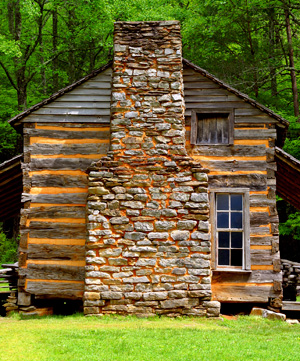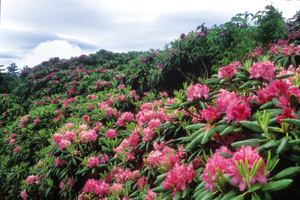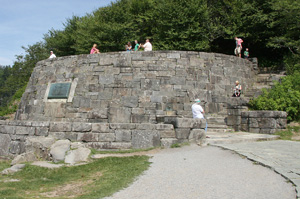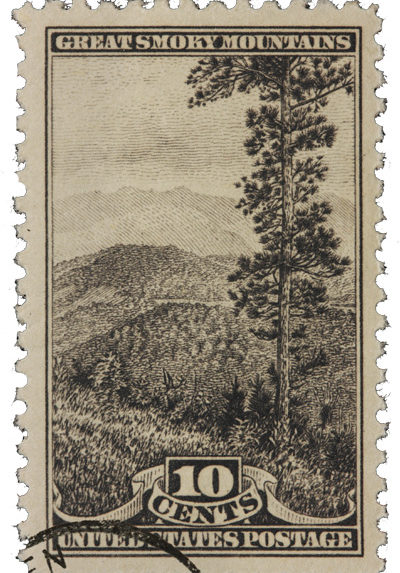Light the candles, the Great Smoky Mountains National Park is 75 years old this summer. Standing at Newfound Gap with the hazy ridges of the Appalachians stretching to the horizon, I try to visualize what the scene looked like when President Franklin D. Roosevelt delivered the dedication at this spot. By the time the park was established in 1934, 80 percent of the hills and valleys had been clear cut by timber companies. Not a promising start for what has become the keystone national park east of the Mississippi River.
Yet today you would never guess the mountain slopes had been stripped, the streams silted, and the wildlife decimated. From The Rockefeller Memorial, where FDR stood with one foot in Tennessee and the other in North Carolina, the view is breathtaking. The densely forested hills, verdant valleys, and wildflower-lined roadways show little sign of past abuse.
At the Sugarland Visitor Center at the Gatlinburg, Tennessee, entrance, Ranger Arthur McDade explains the beginnings of the park. “This was the first citizen-driven park in the nation. With the help of $5 million in matching funds from the Rockefeller Foundation, Tennessee and North Carolina raised enough money to purchase the acreage required to establish the park. This park is a testament to citizen efforts to donate and preserve. And with 50 to 80 inches of rain annually and a long growing season, the park is a testament to nature’s ability to recover.”
In the early 1920s the people of Tennessee and North Carolina realized that a park in the Appalachian Mountains could rival the great western parks with both natural beauty and the economic benefits from tourism. The movement developed with citizen advocates and automobile clubs in Knoxville and Asheville leading the way. Finally in 1926, Congress agreed to establish an Appalachian park if the states could acquire 150,000 acres to donate to the federal government.

“First, the Cherokee gave up their land when the government forced them out,” Ranger McDade says. “Then the American-European farmers gave up the land. Now we have a great chunk of the southern Appalachian Mountains preserved for posterity.”
By the time the park became a reality, however, the country was in the midst of the Great Depression and funding for development seemed impossible. But the Civilian Conservation Corps came to the rescue by sending 1,000 young men to build the roads, buildings, and trails that are still the backbone of the park infrastructure.
Though decimated by logging, the mountain ecosystem recovered with the spread of the plants and animals that survived in the hollers and hills too steep to cut. Now a designated UNESCO International Biosphere Reserve, the park boasts more species of plants than all of Europe. An ongoing biological inventory has documented 1,500 species of flowering plants and 130 species of trees. The study has discovered 900 species previously unknown and estimates the park may harbor as many as 100,000 life forms.
Sampling the magic and majesty of the mountains is as easy as getting out of your car and walking down one of the forest trails. Along the road, “Quiet Walkways” lead far enough into the woods to escape road noise. Yet, according to the park administrators, five out of six of the nearly 10 million visitors have only a “windshield experience.”

Courtesy: Gatlinburg Department of Tourism
“We offer lots of ways to see the park,” says Nancy Gray, park public relations officer. “We have auto trails with stops and printed guides and self-guided nature trails from one-fourth to one-mile long. From June through October, rangers lead interpretive hikes and present programs. Best of all, the park has 800 miles of trails that vary from easy strolls to 71-mile hikes of the Appalachian Trail.”
For an introduction to the lure of the Smokies, we hike to Laurel Falls, a 1.3-mile walk through a forest of oaks and maples with a dense understory of mountain laurel and rhododendron. In June flamboyant blooms cover the shrubs, and in the fall the maples turn blushing hues of reds and oranges. Today shades of green color the valleys and distant ridges. Couples pushing strollers and people of all ages flock down the family-friendly, paved trail to the 80-foot waterfall.
Besides the wonders of nature, the park preserves seven historic districts where settlers carved out small farming communities in the rich valleys. The Cades Cove district preserves 10 cabins, barns, outbuildings, and churches from the 125 families that lived here in 1900. An 11-mile, one-way loop circles the perimeter with abandoned fields in the center.
To get a closer feel for the land and its pioneer inhabitants, we rent bicycles at the visitor center and cruise the rolling, winding lane. A cloudless blue sky and precipitous mountain ridges frame fields chest-high in grass and sunflowers. With little road traffic, the silence of history mingles with the whisper of the breeze. We stop at log cabins with split-rail fences and walk among the weathered gravestones in cemeteries behind white, clapboard churches. The land shaped the lives of these farmers as much as they shaped it.

Photo courtesy Gatlinburg Department of Tourism
Though majestic, the view also captures the history of mountains under siege since the first axmen invaded the pristine forests. Dead-standing Fraser fir trees killed by balsam woolly adelgid, an Asian parasite introduced in 1963, surround the tower. In 1929, the chestnut blight from Asia killed the keystone tree species and forever changed the makeup of the ecosystem. The latest threat to the forest emerged in 2002 when another Asian woolly adelgid that kills hemlock, another keystone species of the forest, entered the park.
Axes and plows decimated the forests of the Smoky Mountains in the past, and imported species threaten the future, but they are minor disturbances compared to what these resilient mountains have endured through the ages. Born from the collision of tectonic plates 200 million years ago, the Appalachian range has seen its rugged peaks worn down to rounded domes, ice ages come and go, and climate changes from near subarctic to today’s moderate winters. After seven decades of the healing touch of undisturbed nature, the rejuvenated Smokies once again have the power to inspire even the drive-through tourist.
Become a Saturday Evening Post member and enjoy unlimited access. Subscribe now




Comments
My daughter and I visited Great Smoky Mountains National Park some years ago. It remains one of our favorite memories. Even though the park was quite crowded, the expanse of the wilderness gave us the feeling of space and serenity. We drove the loop mentioned above and enjoyed every rock, tree, and flower that we were privied to. The park is a bit of Americana that no one should miss seeing. My daughter, who is an artist, painted a lovely scene that incorporated the view from John’s Cabin. It is my wallpaper on my computer, so I relive that day every time I log on.
In limited response to Jesuit, you should visit unesco.org and educate yourself about UNESCO. The Great Smoky Mountains National Park is owned by the people of the US, in stewardship of the US government as a national park. As a resident in the area I have met visitors from all over the world. As a rain forest with a diversity of still undiscoved species it is actively researched by an international community of scientists and many of those scientists return to visit with their families when their research is concluded. The designation as an International Biosphere Preserve by the United Ntions is to emphasize the importance of protecting and maintaining the area.
The Smokies are great because of rangers like Butch McDade. Happy retirement, Butch! See you at WWW in January.
Hoosier Hiker (who brought the students)
The Great Smoky Mountains National Park–a wondrous span of earth, present in and supposedly belonging to The United States Of America–is “a designated UNESCO International Biosphere Reserve.”
Who allowed such a travesty? And why?